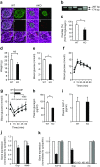Pancreatic alpha cell-selective deletion of Tcf7l2 impairs glucagon secretion and counter-regulatory responses to hypoglycaemia in mice
- PMID: 28343277
- PMCID: PMC5423960
- DOI: 10.1007/s00125-017-4242-2
Pancreatic alpha cell-selective deletion of Tcf7l2 impairs glucagon secretion and counter-regulatory responses to hypoglycaemia in mice
Abstract
Aims/hypothesis: Transcription factor 7-like 2 (TCF7L2) is a high mobility group (HMG) box-containing transcription factor and downstream effector of the Wnt signalling pathway. SNPs in the TCF7L2 gene have previously been associated with an increased risk of type 2 diabetes in genome-wide association studies. In animal studies, loss of Tcf7l2 function is associated with defective islet beta cell function and survival. Here, we explore the role of TCF7L2 in the control of the counter-regulatory response to hypoglycaemia by generating mice with selective deletion of the Tcf7l2 gene in pancreatic alpha cells.
Methods: Alpha cell-selective deletion of Tcf7l2 was achieved by crossing mice with floxed Tcf7l2 alleles to mice bearing a Cre recombinase transgene driven by the preproglucagon promoter (PPGCre), resulting in Tcf7l2AKO mice. Glucose homeostasis and hormone secretion in vivo and in vitro, and islet cell mass were measured using standard techniques.
Results: While glucose tolerance was unaffected in Tcf7l2AKO mice, glucose infusion rates were increased (AUC for glucose during the first 60 min period of hyperinsulinaemic-hypoglycaemic clamp test was increased by 1.98 ± 0.26-fold [p < 0.05; n = 6] in Tcf7l2AKO mice vs wild-type mice) and glucagon secretion tended to be lower (plasma glucagon: 0.40 ± 0.03-fold vs wild-type littermate controls [p < 0.01; n = 6]). Tcf7l2AKO mice displayed reduced fasted plasma glucose concentration. Glucagon release at low glucose was impaired in islets isolated from Tcf7l2AKO mice (0.37 ± 0.02-fold vs islets from wild-type littermate control mice [p < 0.01; n = 6). Alpha cell mass was also reduced (72.3 ± 20.3% [p < 0.05; n = 7) in Tcf7l2AKO mice compared with wild-type mice.
Conclusions/interpretation: The present findings demonstrate an alpha cell-autonomous role for Tcf7l2 in the control of pancreatic glucagon secretion and the maintenance of alpha cell mass and function.
Keywords: Alpha cell; Diabetes; GWAS; Gene; Glucagon; Islet.
Conflict of interest statement
Data availability
Data are available on request from the authors.
Funding
GdSX thanks Diabetes UK (BDA 13/0004672), EFSD-MSD and Rosetrees Trust for Project grants. This work was funded by grants to GAR from Diabetes UK (Project BDA 11/0004210), the Wellcome Trust (Programme 081958/Z/07/Z; Senior Investigator Award WT098424AIA), and the MRC (UK; Project GO401641; Programme MR/J0003042/1). The work leading to this publication also received support from the Innovative Medicines Initiative Joint Undertaking under grant agreement no. 155005 (IMIDIA) (GAR, CM, PLH), resources of which are composed of a financial contribution from the European Union’s Seventh Framework Programme (FP7/2007–2013) and EFPIA companies’ in kind contribution.
Duality of interest
The authors declare that there is no duality of interest associated with this manuscript.
Contribution statement
GdSX and GAR conceived and designed the studies and co-wrote the article. PLH provided PPG
Figures



Similar articles
-
METRNL represses beta-to-alpha cell trans-differentiation to maintain beta cell function under diabetic metabolic stress in mice.Diabetologia. 2025 Aug;68(8):1769-1788. doi: 10.1007/s00125-025-06459-7. Epub 2025 Jun 10. Diabetologia. 2025. PMID: 40495021
-
Proinflammatory cytokine-induced alpha cell impairment in human islet microtissues is partially restored by dual incretin receptor agonism.Diabetologia. 2025 Jul;68(7):1492-1508. doi: 10.1007/s00125-025-06425-3. Epub 2025 May 15. Diabetologia. 2025. PMID: 40374968 Free PMC article.
-
TMEM55A-mediated PI5P signalling regulates alpha cell actin depolymerisation and glucagon secretion.Diabetologia. 2025 Jul;68(7):1509-1523. doi: 10.1007/s00125-025-06411-9. Epub 2025 Mar 26. Diabetologia. 2025. PMID: 40140059 Free PMC article.
-
Glycaemic thresholds for counterregulatory hormone and symptom responses to hypoglycaemia in people with and without type 1 diabetes: a systematic review.Diabetologia. 2022 Oct;65(10):1601-1612. doi: 10.1007/s00125-022-05749-8. Epub 2022 Jul 22. Diabetologia. 2022. PMID: 35867127 Free PMC article.
-
Various strategies to induce beta cell neogenesis: a comprehensive review for unravelling the potential future therapy for curing diabetes.Growth Factors. 2025 May;43(2):69-96. doi: 10.1080/08977194.2025.2508723. Epub 2025 May 21. Growth Factors. 2025. PMID: 40400239 Review.
Cited by
-
TCF7L2 promotes anoikis resistance and metastasis of gastric cancer by transcriptionally activating PLAUR.Int J Biol Sci. 2022 Jul 11;18(11):4560-4577. doi: 10.7150/ijbs.69933. eCollection 2022. Int J Biol Sci. 2022. PMID: 35864968 Free PMC article.
-
TCF7L2 lncRNA: a link between bipolar disorder and body mass index through glucocorticoid signaling.Mol Psychiatry. 2021 Dec;26(12):7454-7464. doi: 10.1038/s41380-021-01274-z. Epub 2021 Sep 17. Mol Psychiatry. 2021. PMID: 34535768 Free PMC article.
-
Mechanisms and Physiological Roles of Polymorphisms in Gestational Diabetes Mellitus.Int J Mol Sci. 2024 Feb 7;25(4):2039. doi: 10.3390/ijms25042039. Int J Mol Sci. 2024. PMID: 38396716 Free PMC article. Review.
-
Walking a fine line between β-cell secretion and proliferation.J Biol Chem. 2018 Sep 7;293(36):14190-14191. doi: 10.1074/jbc.H118.005121. J Biol Chem. 2018. PMID: 30194258 Free PMC article. Review.
-
Adipocyte-specific deletion of Tcf7l2 induces dysregulated lipid metabolism and impairs glucose tolerance in mice.Diabetologia. 2021 Jan;64(1):129-141. doi: 10.1007/s00125-020-05292-4. Epub 2020 Oct 17. Diabetologia. 2021. PMID: 33068125 Free PMC article.
References
Publication types
MeSH terms
Substances
Grants and funding
LinkOut - more resources
Full Text Sources
Other Literature Sources
Medical
Molecular Biology Databases

